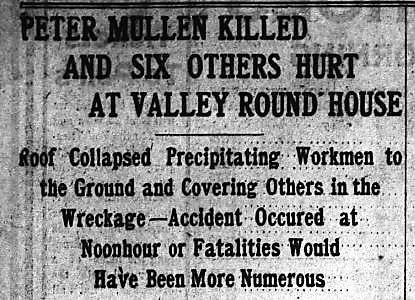If it had not been for lunch hour, more workers would have perished or been injured when the roof at the Lehigh Valley roundhouse in North Wilkes-Barre collapsed, killing one man on Oct. 20, 1908.
Peter Mullin, 30, who lived at 5 Auburn St., Wilkes-Barre, a laborer at the Lehigh Valley railroad shop yards along today’s North Wilkes-Barre Boulevard, was killed and six others were injured in the roof collapse that happened just before 1 p.m.
Mullin and five other men were replacing the slate roof of the roundhouse built in 1875.
“The crash occurred a few minutes before the time the employees resumed work after their noon lunch hour. Some were just returning to the roundhouse when the accident occurred, others were inside, but a majority of the men were still in the shop yards when the roof went down,” the Wilkes-Barre Times newspaper reported Oct. 21, 1908.
Railroad yard workers walking toward the roundhouse rushed to the wreckage after the collapse.
“Little time was required to rescue the men inside the building. This proved a rather difficult task owing to the tons of wreckage which had covered them. When they were extricated from the wreckage they were first carried to the company offices in the yard and after receiving medical treatment, were removed to their homes, boarding rooms or conveyed to the hospital,” the newspaper reported.
A large crowd gathered at the site, resulting in Wilkes-Barre City policemen assisting Lehigh Valley Railroad policemen to keep them at a distance as freight and passenger trains had to maintain a schedule and passed by.
“A few employees were stationed at various points about the rail yard to keep the curious persons from going too close,” the Times reported.
Those who were brave enough to enter the structure risked further collapse as the brick walls threatened to topple.
The Times newspaper reported the roundhouse was constructed with brick walls and iron girders to support the roof covered with slate. Workers were replacing the slate that was stacked in piles, causing an uneven load on the roof.
A coroner’s jury, under the direction of Luzerne County Deputy Coroner W. S. Casterlin, was seated to find fault with the collapse.
Several witnesses, including Thomas Soley, 30, of 301 N. River St., who was one of the five men injured, testified at the coroner’s inquest.
Soley was employed by the Lehigh Valley Railroad as an engine cleaner.
“Soley at the time the roof fell was about to cross from the tank of one locomotive standing in the roundhouse, to the tank of another. He was struck on the back of the head and knocked unconscious. Soley told the coroner’s jury he was aware the roof was being replaced but did not know the roof was structurally unsafe,” the Times Leader reported Nov. 6, 1908.
After several weeks of testimony during the coroner’s inquest, the six-member jury on Dec. 13, 1908, found Lehigh Valley Railroad was negligent in not making repairs to the building that was damaged over time due to the settling of the ground that weakened the foundation and walls of the roundhouse.
Lehigh Valley repaired the roundhouse after the collapse but abandoned the structure in early 1939, transferring locomotive repairs and maintenance to their Coxton roundhouse in Pittston. The roundhouse that once stood along North Wilkes-Barre Boulevard was demolished in November 1939.
Reach Ed Lewis at 570-991-6116 or on Twitter @TLEdLewis.

